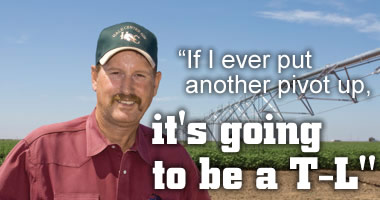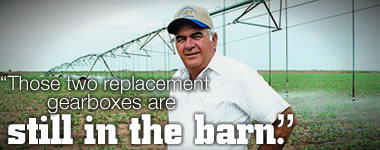 | Abernathy, Texas |
 A fourth-generation farmer in the area, his exclusive crop is cotton, with milo only as a backup crop. Cotton yields range from 300 pounds per acre dry land to 1,600 pounds per acre under the center-pivot irrigation.
A fourth-generation farmer in the area, his exclusive crop is cotton, with milo only as a backup crop. Cotton yields range from 300 pounds per acre dry land to 1,600 pounds per acre under the center-pivot irrigation.
Wayne started installing center pivots in 1992. As he ruefully smiles now, “Those were electric drives, with high impact sprinklers and high water pressure. In a good wind I could walk underneath a sprinkler and not get wet. The wind would just blow all the water away.”
As the years passed, McGuire went to low pressure sprinklers, and kept moving the nozzles closer and closer to the soil. Now all of his sprinklers are equipped with hoses or bubble nozzles, which he thinks are the ultimate, “Because, in this country every drop counts.
“They call it semi-arid for a reason and there’s less water every year. Once the crop is knee-high I don’t want to see any water coming out of a sprinkler. There’s really little evaporation with bubblers-a gallon of water on the ground will go further than a gallon sprayed into the air.”
Then, in 1998 his first T-L pivot system went in, and his next center-pivot was another T-L bought this past spring.
As an indication of current water availability, he has two older systems that need five wells each to provide 350 gpm of flow. The newer T-L’s water comes from four wells and is nozzled for a 450-gallon a minute application.
Wayne considers the most important difference between his electric systems and his hydraulically powered T-Ls is the continuous movement provided by the T-L center-pivots. He comments that, “Those T-Ls sure are smooth. I think this makes the water go further.”
“We’re always having gearbox problems with the electric systems since they jerk and stop so much,” McGuire reports.
“As for my T-Ls, they’re smooth, no jerking and shaking. My ten-year-old T-L has had just one gearbox go out. And that happened because a wrong wheel was put on after a flat tire.”
“Cotton under a continuously moving T-L seems to be more uniform,” he continues. “I also think a T-L is more efficient, since it puts out water with more uniformity. Fertilizer that I apply through the system also goes on more evenly.”
“There’s another efficiency the T-Ls have”, he states. His T-Ls neither break down nor do they ever stay in one spot while the fertilizer keeps running as his electric units have done. “Thus,” he says, My T-Ls save additional fertilizer expense and prevent some heavily over fertilized areas.”
McGuire, probably in common with the majority of farmers, says, “Electricity scares me to death. It’s not fun working with electricity when you’re standing in water.”
He has learned to safely fix simple electrical problems, but anything major is a call to an electrician.
As for fixing his T-Ls himself, he notes that, “I guess I could, but I haven’t had anything yet that needed repairs.”
“A T-L will get my money back faster, because it doesn’t break down as much as an electric system,” McGuire continues. “Just look at minimum of moving parts a T-L has.
“When a sprinkler stops in the heat of summer it costs me. So the center-pivot that’s running is going to make me a lot more money than the one that’s broken down.”
He also believes his T-Ls are built a little better than the electrics. He’s heard truckers who haul the systems say that the T-Ls weigh more than the other brands they carry.
McGuire’s T-L dealer worked with him to customize the installation of his newest system. He positioned all the outlets so the hoses with bubbler nozzles would drop exactly in every in every other furrow planted.
Wayne also planted his rows in circles. This prevents towers from either skipping or running over rows and allows McGuire to fully utilize his precision farming equipment. For example, he can apply fertilizer in next to the plant, under it or sidedress precisely three or four inches away, his choice.
“Maintenance-free, efficient, easy to use, and built any way you want,” he sums up. “That’s why when anyone asks me about center-pivots I tell them, ‘You’ll be happier with a T-L, especially in the long run’.
Using wheat as cover crop for cotton McGuire considers one of his best crop management strategies applied in recent years was planting wheat-strictly to aid his cotton and not to be harvested. The problem is the sandy soil that a strong wind can easily whip into small particles that shred the fragile cotton seedlings. Hail or even a hard rain can also seriously damage the young cotton. To prevent much of this damage, McGuire seeds wheat, then applies herbicide to kill the wheat in April. Three or four weeks later he plants his cotton into the cover crop.
The result: The wheat stalks protect the cotton plants, giving them a good, stress-free start toward good yields-200 to 400 pounds or more an acre!
 | Ropesville, Texas |
 Because a day of downtime can ruin a cotton crop, Joe Rhoads in Ropesville, Texas, decided that he’d play it cautious when he purchased his first center pivots in 1991, a pair of T-Ls.
Because a day of downtime can ruin a cotton crop, Joe Rhoads in Ropesville, Texas, decided that he’d play it cautious when he purchased his first center pivots in 1991, a pair of T-Ls.
“I bought two gearboxes and stuck them in the barn so if I needed quick repairs I’d have them handy,” he remembers. “After 14 seasons, those two replacement gearboxes are still in the barn.
“Now I have eight T-Ls, and they all still look like new,” he adds. “So far, I’ve never had to call anyone out of town to fix anything. Also, we try to farm more acres per person than most farmers, and so we just don’t have time for systems that don’t work.”
Realizing back then that he needed to vastly improve his watering efficiency due to a decreasing aquifer, Rhoades decided center pivots were the answer. But, which brand to buy?
To benefit from the experience of other farmers, he drove more than 100 miles talking to center pivot users and getting their recommendations.
He even talked to a trucker who told him that, due to their greater weight, three T-Ls put him over his weight limit. He said he could easily haul three of another brand. Rhoades also says he’s never heard of a T-L being blown over in a strong Texas straight wind, but knew of several instances of this happening with other brands.
“The final clincher was that I read in the paper about a farmer being found dead by his electric center pivot,” Rhoades says, “I have four sons and the man who works for me has five sons. An electric system just wasn’t worth the risk.
“However, the main reason I went with T-L was I could take care of servicing and repairing them myself,” he continues. “Some of the farmers I talked to had to wait for four or five days with a down pivot for an electrician to arrive.”
Rhoades quickly learned about the difference in efficiency between row watering and center pivot irrigation. In a side-by-side comparison of two cotton fields, one watered with an eight inch surge system and the other with a T-L center pivot, “Both ran the same gallons per minute per acre,” he reports. “The row watered field made 601 pounds an acre and the T-L field made 1,051 pounds,”
He concluded that his ability to put water on so the cotton was never stressed made the difference. The T-L could give a little drink twice a week, while it took almost a month to get across the row watered field
To minimize evaporation today, Rhoades utilizes drag hoses that deliver a wet strip 20 inches wide down the middle of every other furrow. This concentrates the water and eliminates 75 percent of the evaporation area.
“I could have bought cheaper systems,” he observes, “But, I believe you get what you pay for. I felt then, and still do today, that T-Ls are worth any extra cost.”
Bob Faver farms near Dalhart, Texas, where for the last five years rainfall has been roughly a third of the normal 12 to 14 inches annual average. He says his number one reason for liking his T-Ls is, “The continuous movement that’s not offered by an electric center pivot. For some crops this is a big issue. Plus, without all that starting and stopping there’s less wear and tear on the machine.
“It’s just a ballpark guess, but I’d say my T-Ls are surely 20 percent less trouble than my electrics.” He comments that while his ten year old T-Ls will eventually need some refurbishing, this will be mostly replacing hoses and probably little else.
“The structure of the T-L machine is excellent. It will be there a long time,” he says. The T-L is a good quality product. About all we have to do before every season is change fi lters, make sure the gearboxes are full, and check for leaks, and then go.” On the other hand, his electrics always seem to have a switch or a motor that’s bad, he notes.
“The nice thing about hydraulics is that I can fi x any problem myself. That’s not the case with an electric system. I’ve never been comfortable with electricity either,” Faver adds. “If you’re just not thinking one time, then you could be dead.”
NO-TILL Helps Provide Ground Cover
Now in his fi fth year of all no-till, Rhoads recalls what fi nally prompted his decision. Frowning as he spoke he said, “After going across the cotton 13 times fi ghting sand, working seven days a week, dog tired, we still ended up losing our crop. We knew we had to do something to get some ground cover.”
After his first year of no-till farming, he thought a 3 inch rain had completely missed his cotton fi eld since he saw water running off his neighbor’s land and not his. In his view, this was an excellent illustration of no-till effectiveness. The water was actually being retained in his field.
 | Floydada, Texas |
 Having received only two inches of rain since September, Jaron Everett’s dry land cotton plants hadn’t yet seen blue sky by early June, 2006. He now irrigates 90 percent of his 1,100 acres with T-L pivots. That doesn’t include the 600 acres of cotton he usually plants into milo stubble under minimum-till, ridge-till near Floydada, Texas.
Having received only two inches of rain since September, Jaron Everett’s dry land cotton plants hadn’t yet seen blue sky by early June, 2006. He now irrigates 90 percent of his 1,100 acres with T-L pivots. That doesn’t include the 600 acres of cotton he usually plants into milo stubble under minimum-till, ridge-till near Floydada, Texas.
“If all I had was dry land, even in a normal rainfall year, it would take approximately 4,000 acres in order to harvest the same amount of cotton,” he points out. In 2006, he began irrigating with a new T-L pivot as a supplement to row irrigation and a “Spark-O-Matic” center pivot that he refuses to claim.
“One day I plan on having 100 percent T-Ls,” he smiles. “That’s because this is like getting some irrigated acres for free, plus a higher yield of cotton. It’s the only brand I’ll ever purchase again. “The year before, my row irrigated cotton averaged one and a half bales an acre. I’m looking at an increase to two and a half bales an acre with my T-L,”
Everett continues, noting that the T-L is nozzled for just 300 gallons a minute fed from two wells. Under row irrigation that same setup could water only eight rows at a time, and a maximum of 75 acres.
“Now, my T-L waters 125 acres more efficiently, without too much water here and too little water there,” he explains. “Basically, it’s allowed me to irrigate another 50 acres with the same amount of water.”
However, one thing Everett didn’t count on before he began utilizing center pivot sprinklers was more family time. He’s a single dad, and getting home at 2 a.m. or 3 a.m. every day due to row irrigation labor needs just wasn’t working for him.
“Yes, my T-L has knocked down my stress level, but I’d always heard that the T-L was the Cadillac of all sprinklers,” says Everett. “When I went to look at center pivots, I could tell by how they were designed that T-L was the best. Its cost doesn’t matter when I think about what my T-L has saved me in time, frustration, water, and money compared to row irrigation.”
After a summer comparing his T-L to an electric center pivot, Everett was also convinced that, “My T-L is going to cover more acres with less water than the electric. I found my cotton was more evenly watered with the T-L, too. It placed the water exactly where it needed to be–I call it ‘precise irrigation’.”
He attributes this to the T-L’s continuous movement. There’s no repeated starting and stopping so that some areas get more or less water than other areas in the field. This past spring he learned that the T-L’s pre-watering moisture was consistent in the beds, while the electric system’s wasn’t, as evidenced by the dry/wet spots.
“That’s not the only problem with an electric system,” Everett points out. First, he considers the electricity factor “really scary.”
“It also seems I’m always having to call the service man to come out to fix fuses or micro switches or one of those little U-joints or something,” he says. “Its high maintenance costs are killing me. It takes hours, sometimes days, to get parts, too. I think with an electric center pivot, you need to be a certified electrician to work on them. That’s not my job. My job is to farm. With a T-L, all it takes is a little common sense and a few minutes if you understand hydraulics. Also, I’m not afraid to climb on it to check something out or to make adjustments as I am with the electric.”
He says he considers it mandatory to check his electric center pivot at least twice a day, since it has so many moving parts and electric motors and micro switches. On the other hand, he looks at his T-L just once daily, and observes that, “I’ve never come out to the field and found that it’s not been working.”
If Everett needed another reason to prefer T-L pivots, it’s the fact that the water table in his region continues to recede. As a result, row irrigation doesn’t allow enough acres to be covered with the available wells, nor can the needed yields of cotton be harvested.
“We need to maximize our water with precise watering techniques,” he believes. “My T-L will exactly do that. With the old ‘row water’ techniques pounding at profits, we farmers can’t afford not to use center pivot irrigation if we want to stay in business.
“Water timing is key to making a cotton crop under my T-L,” Everett sums up. “I can’t say enough about my T-L.”
